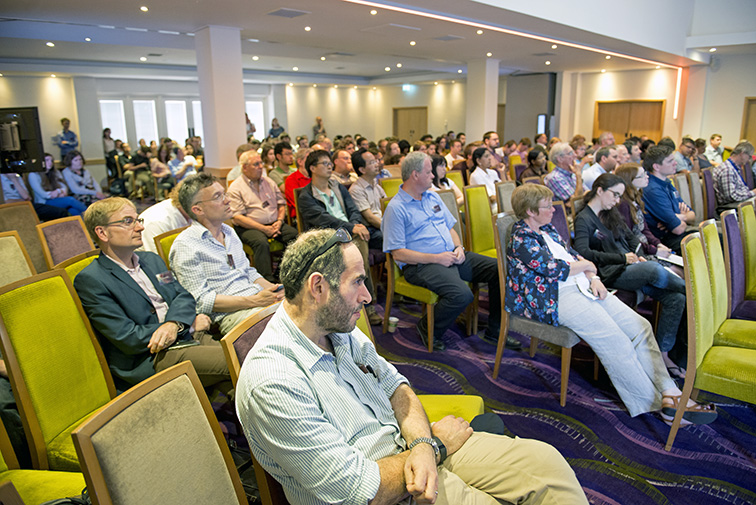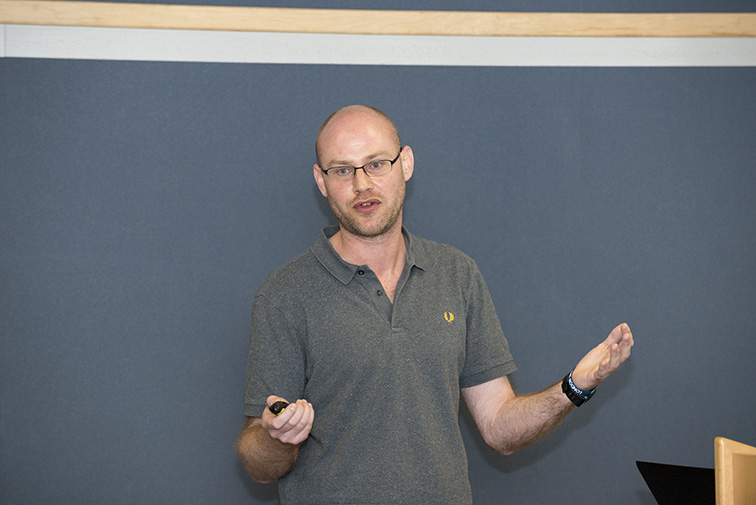The annual UK Neutron and Muon Science and User Meeting (NMSUM) was hosted in Warwick, UK, and brought together researchers using the neutron instruments at the ISIS Neutron and Muon Source, UK, and the Institut Laue-Langevin (ILL) in France.
Around 10 million lives are lost each year to infectious diseases such as malaria, which are spread by pathogens like bacteria, parasites and fungi. Although the percentage of total deaths caused by infectious diseases has fallen by two thirds in the last 100 years, there are still some diseases which cannot be cured, and the challenge of increasing resistance to antibiotics threatens to plunge us back into a world where diseases like tuberculosis reign uncontested.
In attempts to find new ways to combat infectious diseases, researchers are turning to an unusual analytical tool – something found in almost every atom in the Universe – neutrons. Beams of neutrons can be used as a ‘super-microscope’, focussing on atoms within a sample and interacting with the nuclei in order to visualise exactly where the atoms are and what they’re doing.
Fighting Fungi
For the last 50 years, an antifungal drug called Amphotericin B (AmB) has been our last line of defence against systemic fungal infections such as pneumonia or histoplasmosis. However, instances of resistance to the drug are increasing, and the toxic side effects of AmB on the kidneys continue to limit its use.
Fungi are opportunistic pathogens, meaning they often attack people with weak immune systems, such as those undergoing chemotherapy or suffering from AIDS. Although fungi don’t receive much publicity, to an immunocompromised patient they could be lethal.
The antifungal drug is thought to destroy fungi by creating pores in their cell membrane, resulting in unrestricted ion flow and cell death. The drug targets fungi specifically due to the difference in cell membrane structure in humans and fungi; cell membranes contain cholesterol in humans and ergosterol in fungi. However, the mechanism of AmB’s specific action has not fully been deduced. Dr Dave Barlow’s research group from King’s College London are trying to do just that, using neutron diffraction at ISIS and the ILL. “We need to be able to ‘highlight’ selected parts of the systems, and make other parts ‘invisible’,” said Dr Barlow. “This ‘contrast’ is something that is uniquely provided by using neutrons.”
Using small angle neutron scattering on the LOQ and SANS2D instruments at ISIS to study model membranes, Dr Barlow’s group have discovered that Amphotericin B induced a similar structural change in both human and fungal membranes, although this change occurs quickest in membranes containing ergosterol. The speed of interaction also depends on the formulation. When AmB is paired with sodium cholesteryl sulfate (SCS), as in the drug Amphotec, the drug interacts with the fungal membrane immediately, and structural change can be detected in two to ten seconds. The same process takes two minutes in cholesterol membranes, and 25 minutes in membranes completely lacking lipid, representing an obvious specificity for ergosterol. Future work can now be devised to outline the mechanism behind the specificity, minimising interactions with human cell membranes and reducing side effects.

The latest findings in the development of drugs to tackle infectious diseases and antibiotic resistance were presented at the annual UK Neutron and Muon Science and User Meeting (NMSUM) in Warwick on the 27th July 2016. Credit: STFC
View full-size image
Exploiting our own Immune System
Another avenue Dr Barlow is exploring is the use of key members of the innate immune system, known as anti-microbial peptides (AMPs), to treat disease. “AMPs are mostly found in the tissues and organs exposed to airborne pathogens,” he explains. “They are thought to provide our first line of defence against invading microbes.”
There have been over 5000 AMPs discovered in not just mammals but other animals and bacteria, too; human AMPs include histatin and defensin proteins. This work remains in its early stages, with a 2014 review stating that there are currently 7 AMPs in human clinical trials, with none in clinical use at the present time.
Dr Barlow’s investigations into the functions of two AMPs, Rhesus θ-Defensin 1 (RTD-1) and porcine protegrin-1 (PG-1), using model bacterial membranes and neutrons have discovered that AMPs will bind to cell membranes using positively charged groups (NH3+) on arginine residues. If AMPs carry a lot of these residues then they’ll interact readily with any membrane, including human, which will lead to nasty side effects. The way to avoid self-attack, Dr Barlow’s studies conclude, is to prevent so called “charge clustering”, by spreading positive groups across the peptide in order to prevent excessive pore formation in human cells and minimise collateral damage.
HIV Hopes
It is thought that the HIV/AIDS epidemic began in the late 1970s, with an estimated 36.9 million people worldwide currently living with the virus. Although knowledge has progressed quite a lot in the last 40 years, demand still exists for effective HIV treatments. Dr Matthew Blakeley, research scientist at the ILL, is working on providing them. He’s collaborating with scientists across the UK and US, using neutron science to analyse the interactions between HIV-1 protease, an enzyme essential for the formation of mature viral proteins, and therefore HIV infectiousness, and enzymes that inhibit them.
Studies using x-rays have already yielded a drug called Daruvanir, a small molecular protease inhibitor that forms more hydrogen bonds with its target than its predecessors. However, Dr Blakeley’s group are identifying further optimisation opportunities using neutrons. They found that they could increase the binding efficiency of the protease with its inhibitor, and therefore reduce drug resistance of HIV, by including more “bulkier” reactive groups to displace the water molecules that currently mediate the interaction. More hydrogen bond-forming groups on the main carbon chain would also be beneficial, as would help to preserve the interaction even if the virus mutates.

Dr Matthew Blakeley, research scientist at the ILL, uses neutrons to carry out research into new and effective HIV treatments. Credit: STFC
View full-size image
Why Neutrons?
Historically, x-rays have been used for structural biology research; however, this method can produce incomplete biological pictures. Whereas neutrons are scattered by the atomic nuclei, x-rays are deflected by orbiting electrons, and the strength of scattering depends on electron number. As most biological interactions are mediated by hydrogen atoms, which possess only a single electron, hydrogen is hard to ‘see’ using x-ray diffraction, but is easily visible with neutrons. X-rays are also ionising, meaning experiments must be carried out at cryogenic temperatures as low as 100k to prevent damage to the sample by radiation. Neutrons, however, are non-destructive, allowing tests to be conducted more closely to physiological temperatures.
By using both x-ray and neutron data together to analyse drug and microbe interactions, researchers can get a complete picture of the process, and use this information to design more specific and efficient drugs.
Ashley Carley
Research date: July 2016
Further Information The UK Government/Wellcome Trust 2014 Review on Antimicrobial Resistance can be found here.
Review on Antimicrobial Resistance. Antimicrobial Resistance: Tackling a Crisis for the Health and Wealth of Nations. 2014.'
A study on deaths from infectious disease in England and Wales can be found here.
Arkwright, P. D. and David, T. J. (2005) Past mortality from infectious diseases and current burden of allergic diseases in England and Wales. Epidemiology and Infection, 133(6), pp.979-984.
DOI: 10.1017/S0950268805004516
Papers featuring Dr Barlow's work include:
Dabkowska, A., Collins, L., Barlow, D., Barker, R., McLain, S., Lawrence, M. and Lorenz, C. (2014). Modulation of Dipalmitoylphosphatidylcholine Monolayers by Dimethyl Sulfoxide. Langmuir, 30(29), pp.8803-8811.
DOI: 10.1021/la501275h
Foglia, F., Lawrence, M., Demeė, B., Fragneto, G. and Barlow, D. (2012). Neutron diffraction studies of the interaction between amphotericin B and lipid-sterol model membranes. Sci. Rep., 2.
DOI: 10.1038/srep00778
Foglia, F., Rogers, S., Webster, J., Akeroyd, F., Gascoyne, K., Lawrence, M. and Barlow, D. (2015). Neutron Scattering Studies of the Effects of Formulating Amphotericin B with Cholesteryl Sulfate on the Drug's Interactions with Phospholipid and Phospholipid–Sterol Membranes. Langmuir, 31(29), pp.8042-8051.
DOI: 10.1021/acs.langmuir.5b01365
A study on antimicrobial peptides in clinical trials can be found here.
Padhi, A., Sengupta, M., Sengupta, S., Roehm, K. H. and Sonawane, A. (2014) Antimicrobial peptides and proteins in mycobacterial therapy: Current status and future prospects. Tuberculosis, 94(4), pp. 363-373.
DOI: 10.1016/j.tube.2014.03.011
Papers featuring Dr Blakeley's research include:
Gerlits, O., Wymore, T., Das, A., Shen, C., Parks, J., Smith, J., Weiss, K., Keen, D., Blakeley, M., Louis, J., Langan, P., Weber, I. and Kovalevsky, A. (2016). Long-Range Electrostatics-Induced Two-Proton Transfer Captured by Neutron Crystallography in an Enzyme Catalytic Site. Angewandte Chemie, 128(16), pp.5008-5011.
DOI: 10.1002/anie.201509989
Weber, I., Waltman, M., Mustyakimov, M., Blakeley, M., Keen, D., Ghosh, A., Langan, P. and Kovalevsky, A. (2013). Joint X-ray/Neutron Crystallographic Study of HIV-1 Protease with Clinical Inhibitor Amprenavir: Insights for Drug Design. J. Med. Chem., 56(13), pp.5631-5635.
DOI: 10.1021/jm400684f
